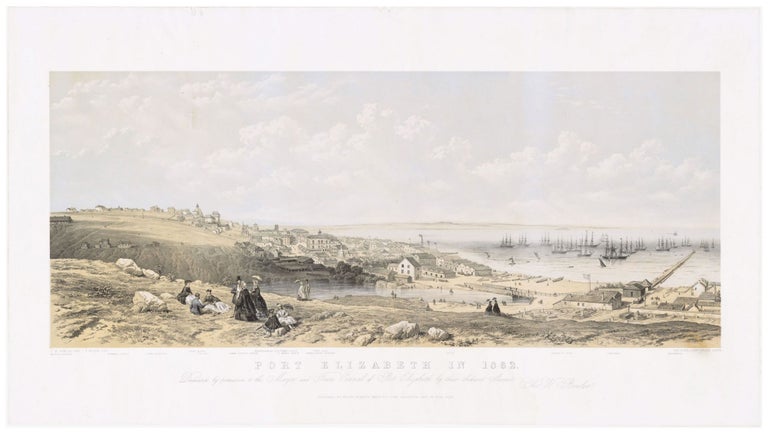Port Elizabeth in 1862. Dedicated by permission to the Mayor and Town Council ...
Port Elizabeth: Richards Impey & Co., [1862 or a bit later]. Three-stone lithograph, 13 7/8” x 33 3/4” plus margins. CONDITION: A few small nicks in sky, a few small thin areas in sky at upper left reinforced on verso with 7” x 1.5” strip of Japanese paper, light toning, minor stains, moderate cockling in margins. An early, important and very rare depiction of the Port Elizabeth, South Africa. Roughly equidistant from Cape Town and Durban, Port Elizabeth was founded in 1820. As a seaport it grew rapidly, to the extent that in 1861, the year before Bowler drew this image, the town was granted autonomous status. After this plate was printed, the arrival of the railways brought even greater growth, so that Bowler’s finely-observed drawing captures the town at an important juncture in its history. The view is taken from the Southwest, from inland looking across the Bakensrivier towards the town with the harbour beyond. The crowded harbor indicates the importance of the sea in the development of the town, with the lighthouse prominent on the skyline. The principal features of the town and harbour facilities are identified by labels below the image. Among these are, at far left, the Military Hospital, built by the British in 1799, while the impressive three-story structure, surmounted by a cupola, is the Town Hall and Commissariat. Thomas Bowler (1812–1869)
Bowler joined the staff of Thomas Maclear, newly appointed as Her Majesty’s Astronomer at the Cape of Good Hope, and travelled to South Africa in 1834. After leaving Maclear’s appointment, he advertised his services as a drawing master and landscape painter. At this juncture he had received no formal training but was entirely entirely self taught. As his career flourished, he returned briefly to London in 1854–1855, to study under landscape artist and lithographer James Duffield Harding. For thirty-five years, from 1834 to 1868, Bowler travelled widely through southern Africa. As he travelled he documented the sights and scenes before him, leaving behind him a substantial body of work: upwards of five hundred original drawings and paintings survive, as well as some seventy large-format prints from his artwork and a large number of smaller illustrations used in the magazines and books of the day. His final foray was to Mauritius, where he painted a series of views, intended for publication as Twenty Views of Mauritius. He travelled to London in 1868 to oversee publication but died there shortly after arrival. In all, Bowler is one of the most important European pictorial eye-witnesses of southern Africa for the mid-19th century, capturing the early flowering of the region’s towns, expanding settlement, the development of the railways and important historical events, including the wars with the local population. Seeking to increase his income, Bowler frequently endeavoured to see his artwork into print, but his attempts at raising subscription income were invariably unsuccessful. and his prints circulated in only limited numbers. This plate was lithographed in London by Thomas Pickens, and printed there by the great printing house “[John Bellenie] Day & Son,” although the publication line bears the imprint of the firm, “Richards, Impey & Co.,” the partnership formed in Port Elizabeth by James Richard and William Impey, newspaper proprietors and letterpress printers. This large format print was published separately, and should be distinguished from the smaller prints that appeared in Bowler’s Pictorial album of Cape Town, with views of Simon’s Town, Port Elizabeth, and Graham’s Town, published by Jan Carel Juta in Cape Town in 1866. Despite its London origin, the view is surprisingly rare, with no impressions found in COPAC, OCLC or the British Museum’s online catalog. The only institutional location traced thus far is a colored example in the London National Maritime Museum. OCLC records only five copies of the later Pictorial Album outside South Africa, with two in America and two in the United Kingdom. Offered in partnership with Boston Rare Maps of Southampton, Massachusetts.
Item #5441
Price: $3,500.00


